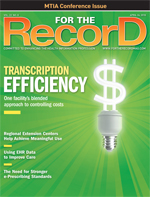 April 26, 2010
April 26, 2010
Coding for Chest Pain
For The Record
Vol. 22 No. 8 P. 27
A common reason for seeking emergency treatment is chest pain. Although the underlying cause may not be cardiac related, the patient should be seen immediately by a physician if the pain continues and radiates to the neck, shoulder, arm, or jaw. If the pain is due to a myocardial infarction, treatment within the first six hours may help prevent further damage to the heart muscle. Pain in any part of the chest may include problems with the heart, lungs, esophagus, muscle, bone, or skin. Chest discomfort or pain that begins or gets worse with exercise, stress, or eating a large meal and goes away with rest may be a warning sign of heart disease.
Other symptoms accompanying cardiac-related chest pain may include chest pressure, fullness, or tightness; a crushing or squeezing pain that radiates to the back, neck, jaw, shoulders, or arms, more commonly affecting the left arm and shoulder; the feeling of a heavy weight on the chest; pain that lasts more than a few minutes then goes away and returns or varies in intensity; shortness of breath; sweating; dizziness or lightheadedness; nausea or vomiting; sudden weakness; and a fast, slow, or irregular heartbeat.
Other symptoms accompanying noncardiac-related chest pain may include a burning sensation behind the sternum, a sour taste in the mouth, difficulty swallowing, fluctuations in pain intensity when there is a change in body position, pain intensification with deep breathing and coughing, and tenderness when pressure is applied to the chest.
Chest pain is classified to ICD-9-CM code 786.50, which may change depending on the exact location, with midsternal or substernal chest pain coded to 786.51 and chest wall or anterior chest wall pain coded to 786.52.
If the pain is described as atypical, musculoskeletal, or noncardiac with no further information on the underlying cause, then code 786.59 is assigned. The documentation of chest discomfort, pressure, and tightness is also classified to this code. These chest pain codes are symptom codes. According to coding guidelines, assign a code for the related definitive diagnosis if one has been established by the physician instead of a code for the symptom.
Some common cardiac-related causes of chest pain may include the following:
• Acute myocardial infarction (category 410) occurs when the coronary arteries are blocked causing damage to the heart muscle.
• Angina occurs when there is plaque buildup in the coronary arteries that temporarily restricts blood flow, usually during exertion. Stable angina (413.9) occurs repetitively and predictably with exercise and goes away with rest. Unstable angina (411.1) is unusual or unpredictable pain not completely relieved with rest or pain that occurs at rest.
• Aortic dissection (441.00 to 441.03) is a tear in the inner lining of the aorta and may cause massive internal bleeding.
• Coronary spasm (413.9), which causes Prinzmetal angina (413.1), results in a temporary stop in blood flow.
• Pericarditis (category 420 or 423) is inflammation of the sac surrounding the heart.
• Mitral valve prolapsed (424.0) is a heart valve abnormality.
• Myocarditis (category 422 or 429.0) is an inflammation of the heart.
• Hypertrophic cardiomyopathy (425.1 or 425.4).
The following are some common digestive causes of chest pain:
• heartburn (787.1);
• gastroesophageal reflux (530.81);
• esophagitis (530.10 to 530.19);
• esophageal spasm (530.5);
• hiatal hernia (553.3);
• achalasia (530.0);
• perforated viscus (799.89);
• cholecystitis, cholelithiasis (categories 574 and 575); and
• pancreatitis (577.0 or 577.1).
Common respiratory causes of chest pain include the following:
• pulmonary embolism (415.11 to 415.19);
• pleurisy (511.0);
• spontaneous pneumothorax (512.8); and
• pulmonary hypertension (416.8).
Some common musculoskeletal causes of chest pain may include costochondritis or Tietze’s disease (733.6), fibromyalgia (729.1), and injured ribs or pinched nerves. Some other causes of chest pain may include a panic attack (300.01), shingles (category 053), and cocaine-induced chest pain (970.8 + 786.50), which should be coded as a poisoning since the patient had a reaction to a drug that was not prescribed.
Coding and sequencing for chest pain are dependent on the physician documentation in the medical record and application of the Official Coding Guidelines for inpatient care. Also, use specific AHA Coding Clinic for ICD-9-CM and American Medical Association CPT Assistant references to ensure complete and accurate coding.
— This information was prepared by Audrey Howard, RHIA, of 3M Consulting Services. 3M Consulting Services is a business of 3M Health Information Systems, a supplier of coding and classification systems to more than 5,000 healthcare providers. The company and its representatives do not assume any responsibility for reimbursement decisions or claims denials made by providers or payers as the result of the misuse of this coding information. More information about 3M Health Information Systems is available at www.3mhis.com or by calling 800-367-2447.



